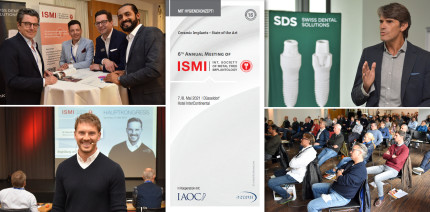ceramic implants (engl.)
Weitere Informationen und Abo auf unserer Website

OEMUS MEDIA AG
Weitere Informationen zum Unternehmen!
ceramic implants (engl.)
Weitere Informationen und Abo auf unserer Website

Georg Isbaner
Weitere Artikel und Informationen zum Autor!
ceramic implants (engl.)
Weitere Informationen und Abo auf unserer Website

OEMUS MEDIA AG
Weitere Informationen zum Unternehmen!

CAMLOG Vertriebs GmbH
Weitere Informationen zum Unternehmen!

BioHorizons® Biomaterialien
Weitere Informationen zum Produkt!

Dr. Dominik Nischwitz
Weitere Artikel und Informationen zum Autor!
ceramic implants (engl.)
Weitere Informationen und Abo auf unserer Website

OEMUS MEDIA AG
Weitere Informationen zum Unternehmen!

Dr. Dominik Nischwitz
Weitere Artikel und Informationen zum Autor!
Literaturverzeichnis
Weitere Informationen

Straumann Group Deutschland
Weitere Informationen zum Unternehmen!

Dr Fabrice Baudot
Weitere Artikel und Informationen zum Autor!

Dr. Giancarlo Bianca
Weitere Artikel und Informationen zum Autor!

Dr. Pascal Eppe
Weitere Artikel und Informationen zum Autor!

Zircon Medical Management AG, Patent™
Weitere Informationen zum Unternehmen!

Dr Fabrice Baudot
Weitere Artikel und Informationen zum Autor!

Dr. Giancarlo Bianca
Weitere Artikel und Informationen zum Autor!

Dr. Pascal Eppe
Weitere Artikel und Informationen zum Autor!
Literaturverzeichnis
Weitere Informationen

Dr. Dirk U. Duddeck
Weitere Artikel und Informationen zum Autor!

Dr. Dirk U. Duddeck
Weitere Artikel und Informationen zum Autor!
Literaturverzeichnis
Weitere Informationen

SDS Swiss Dental Solutions AG
Weitere Informationen zum Unternehmen!

Dr Philippe Jourdan
Weitere Artikel und Informationen zum Autor!
Literaturverzeichnis
Weitere Informationen

Dr Philippe Jourdan
Weitere Artikel und Informationen zum Autor!
Dentalpoint AG – Zeramex
Weitere Informationen zum Unternehmen!
ZERAMEX® XT
Weitere Informationen zum Produkt!

Dr Corbin Popp
Weitere Artikel und Informationen zum Autor!

Dr. Rebekka Hueber
Weitere Artikel und Informationen zum Autor!

Dr. med. dent. Karl Ulrich Volz
Weitere Artikel und Informationen zum Autor!

Dr Corbin Popp
Weitere Artikel und Informationen zum Autor!

Dr. Rebekka Hueber
Weitere Artikel und Informationen zum Autor!

Dr. med. dent. Karl Ulrich Volz
Weitere Artikel und Informationen zum Autor!
Z-SYSTEMS
Weitere Informationen zum Unternehmen!

Paul S. Petrungaro, DDS, MS, DICOI
Weitere Artikel und Informationen zum Autor!
Literaturverzeichnis
Weitere Informationen

Paul S. Petrungaro, DDS, MS, DICOI
Weitere Artikel und Informationen zum Autor!

Dr. Gernot Obermair
Weitere Artikel und Informationen zum Autor!
Literaturverzeichnis
Weitere Informationen

Dr. Gernot Obermair
Weitere Artikel und Informationen zum Autor!
WITAR Consulting GmbH
Weitere Artikel und Informationen zum Autor!

WITAR – Metallfreie Implantologie mit Konzept
Weitere Informationen zum Produkt!

Prof. Dr. Curd M.L. Bollen
Weitere Artikel und Informationen zum Autor!
Literaturverzeichnis
Weitere Informationen

Prof. Dr. Curd M.L. Bollen
Weitere Artikel und Informationen zum Autor!

Dr Hadar Zigdon-Giladi
Weitere Artikel und Informationen zum Autor!

Dr Hadar Zigdon-Giladi
Weitere Artikel und Informationen zum Autor!

Dr Dan Hagi
Weitere Artikel und Informationen zum Autor!

Dr Dan Hagi
Weitere Artikel und Informationen zum Autor!

Straumann Group Deutschland
Weitere Informationen zum Unternehmen!
Dentalpoint AG – Zeramex
Weitere Informationen zum Unternehmen!

CAMLOG Vertriebs GmbH
Weitere Informationen zum Unternehmen!

SDS Swiss Dental Solutions AG
Weitere Informationen zum Unternehmen!

Zircon Medical Management AG, Patent™
Weitere Informationen zum Unternehmen!

ISMI - International Society of Metal Free Implantology
Weitere Informationen zur Fachgesellschaft!
6th Annual Meeting of ISMI
Weitere Informationen und Anmeldung auf unserer Website

„Ceramic Implants – State of the Art“ am 7. und 8. Mai in Düsseldorf
Weitere Informationen und Anmeldung auf unserer Website!
Z-SYSTEMS
Weitere Informationen zum Unternehmen!
WITAR Consulting GmbH
Weitere Informationen zum Unternehmen!
ceramic implants (engl.)
Weitere Informationen und Abo auf unserer Website

„Ceramic Implants – State of the Art“ am 7. und 8. Mai in Düsseldorf
Weitere Informationen und Anmeldung auf unserer Website!
